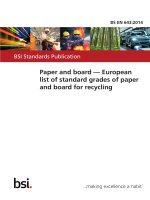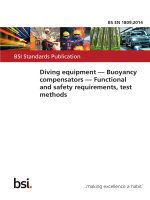Bsi bs en 62288 2014
Bạn đang xem bản rút gọn của tài liệu. Xem và tải ngay bản đầy đủ của tài liệu tại đây (2.34 MB, 132 trang )
BS EN 62288:2014
BSI Standards Publication
Maritime navigation and
radiocommunication equipment
and systems — Presentation of
navigation-related information
on shipborne navigational
displays — General requirements,
methods of testing and required
test results
BS EN 62288:2014 BRITISH STANDARD
National foreword
This British Standard is the UK implementation of EN 62288:2014. It is
identical to IEC 62288:2014. It supersedes BS EN 62288:2008 which
will be withdrawn on 14 August 2017.
The UK participation in its preparation was entrusted to Technical
Committee EPL/80, Maritime navigation and radiocommunication
equipment and systems.
A list of organizations represented on this committee can be obtained on
request to its secretary.
This publication does not purport to include all the necessary provisions of
a contract. Users are responsible for its correct application.
© The British Standards Institution 2014.
Published by BSI Standards Limited 2014
ISBN 978 0 580 76775 3
ICS 47.020.70
Compliance with a British Standard cannot confer immunity from
legal obligations.
This British Standard was published under the authority of the
Standards Policy and Strategy Committee on 31 October 2014.
Amendments/corrigenda issued since publication
Date Text affected
EUROPEAN STANDARD EN 62288
NORME EUROPÉENNE
EUROPÄISCHE NORM September 2014
ICS 47.020.70 Supersedes EN 62288:2008
English Version
Maritime navigation and radiocommunication equipment and
systems - Presentation of navigation-related information on
shipborne navigational displays - General requirements,
methods of testing and required test results
(IEC 62288:2014)
Équipements et systèmes de navigation et de Navigations- und Funkkommunikationsgeräte und -systeme
radiocommunications maritimes - Présentation des für die Seeschifffahrt - Darstellung von
informations relatives à la navigation sur des affichages de
navigation de bord - Exigences générales, méthodes navigationsbezogenen Informationen auf
Navigationsanzeigen für Schiffe - Allgemeine
d'essai et résultats d'essai exigibles Anforderungen, Prüfverfahren und geforderte
(CEI 62288:2014)
Prüfergebnisse
(IEC 62288:2014)
This European Standard was approved by CENELEC on 2014-08-14. CENELEC members are bound to comply with the CEN/CENELEC
Internal Regulations which stipulate the conditions for giving this European Standard the status of a national standard without any alteration.
Up-to-date lists and bibliographical references concerning such national standards may be obtained on application to the CEN-CENELEC
Management Centre or to any CENELEC member.
This European Standard exists in three official versions (English, French, German). A version in any other language made by translation
under the responsibility of a CENELEC member into its own language and notified to the CEN-CENELEC Management Centre has the
same status as the official versions.
CENELEC members are the national electrotechnical committees of Austria, Belgium, Bulgaria, Croatia, Cyprus, the Czech Republic,
Denmark, Estonia, Finland, Former Yugoslav Republic of Macedonia, France, Germany, Greece, Hungary, Iceland, Ireland, Italy, Latvia,
Lithuania, Luxembourg, Malta, the Netherlands, Norway, Poland, Portugal, Romania, Slovakia, Slovenia, Spain, Sweden, Switzerland,
Turkey and the United Kingdom.
European Committee for Electrotechnical Standardization
Comité Européen de Normalisation Electrotechnique
Europäisches Komitee für Elektrotechnische Normung
CEN-CENELEC Management Centre: Avenue Marnix 17, B-1000 Brussels
© 2014 CENELEC All rights of exploitation in any form and by any means reserved worldwide for CENELEC Members.
Ref. No. EN 62288:2014 E
BS EN 62288:2014
EN 62288:2014 - 2 -
Foreword
The text of document 80/733/FDIS, future edition 2 of IEC 62288, prepared by IEC/TC 80 "Maritime
navigation and radiocommunication equipment and systems" was submitted to the IEC-CENELEC
parallel vote and approved by CENELEC as EN 62288:2014.
The following dates are fixed:
• latest date by which the document has to be implemented at (dop) 2015-05-14
national level by publication of an identical national
standard or by endorsement
• latest date by which the national standards conflicting with (dow) 2017-08-14
the document have to be withdrawn
This document supersedes EN 62288:2008.
Attention is drawn to the possibility that some of the elements of this document may be the subject of
patent rights. CENELEC [and/or CEN] shall not be held responsible for identifying any or all such
patent rights.
Endorsement notice
The text of the International Standard IEC 62288:2014 was approved by CENELEC as a European
Standard without any modification.
In the official version, for Bibliography, the following notes have to be added for the standards indicated:
IEC 61162 NOTE Harmonized in EN 61162 series.
IEC 61924-2 NOTE Harmonized as EN 61924-2.
ISO 9241-8:1997 NOTE Harmonized as EN ISO 9241-8:1997 (not modified).
ISO 9241-12:1998 NOTE Harmonized as EN ISO 9241-12:1998 (not modified).
ISO 13406-2:2001 NOTE Harmonized as EN ISO 13406-2:2001 (not modified).
BS EN 62288:2014
- 3 - EN 62288:2014
Annex ZA
(normative)
Normative references to international publications
with their corresponding European publications
The following documents, in whole or in part, are normatively referenced in this document and are
indispensable for its application. For dated references, only the edition cited applies. For undated
references, the latest edition of the referenced document (including any amendments) applies.
NOTE 1 When an International Publication has been modified by common modifications, indicated by (mod),
the relevant EN/HD applies.
NOTE 2 Up-to-date information on the latest versions of the European Standards listed in this annex is
available here: www.cenelec.eu.
Publication Year Title EN/HD Year
IEC 60945 2002 EN 60945 2002
- Maritime navigation and EN 61174 -
IEC 61174 radiocommunication equipment and
- systems - General requirements - EN 61966-4 -
IEC 61966-4 - Methods of testing and required test EN 62065 -
results
IEC 62065 - EN 62388 -
- Maritime navigation and - -
IEC 62388 - radiocommunication equipment and - -
systems - Electronic chart display and
IHO S-52 information system (ECDIS) -
IHO S-52 Annex A of Operational and performance
Appendix 2 requirements, methods of testing and
required test results
Multimedia systems and equipment -
Colour measurement and
management -
Part 4: Equipment using liquid crystal
display panels
Maritime navigation and
radiocommunication equipment and
systems - Track control systems -
Operational and performance
requirements, methods of testing and
required test results
Maritime navigation and
radiocommunication equipment and
systems - Shipborne radar -
Performance requirements, methods of
testing and required test results
Specifications for Chart Content and
Display Aspects of ECDIS
IHO ECDIS presentation library
BS EN 62288:2014
EN 62288:2014 - 4 -
Publication Year Title EN/HD Year
IMO A.694(17) 1991 - -
General requirements for shipborne
IMO A.1021(26) 2009 radio equipment forming part of the - -
IMO MSC.191(79) 2004 global maritime distress and safety - -
system (GMDSS) and for electronic
IMO MSC.192(79) 2004 navigational aids - -
IMO MSC.232(82) 2006 - -
IMO MSC.252(83) 2007 Code on alerts and indicators - -
IMO MSC.302(87) 2010 - -
IMO SN.1/Circ.243/ Rev.1 2014 Performance standards for the - -
VESA-2001-6 - presentation of navigation-related - -
information on shipborne navigational
displays
Performance standards for radar
equipment
Performance standards for electronic
chart display and information systems
(ECDIS)
Performance standards for integrated
navigation systems (INS)
Performance standards for Bridge Alert
Management (BAM)
Guidelines for the presentation of
navigation-related symbols, terms and
abbreviations
Flat Panel Display Measurements
(FPDM)
– 2 – BS EN 62288:2014
IEC 62288:2014 © IEC 2014
CONTENTS
1 Scope..............................................................................................................................9
2 Normative references ......................................................................................................9
3 Terms and definitions .................................................................................................... 10
4 General requirements for all displays on the bridge of a ship ......................................... 15
4.1 Relationship to IMO standards .............................................................................. 15
4.2 Application of IEC 60945....................................................................................... 16
4.2.1 Remark.......................................................................................................... 16
4.2.2 General requirements .................................................................................... 16
4.3 Arrangement of information................................................................................... 16
4.3.1 Consistency of layout .................................................................................... 16
4.3.2 Consistent presentation of information........................................................... 17
4.3.3 Separation of operational display area........................................................... 17
4.4 Readability............................................................................................................ 17
4.4.1 Readability under all ambient light conditions ................................................ 17
4.4.2 Legibility of alphanumeric data and text ......................................................... 19
4.4.3 Presentation of text ....................................................................................... 20
4.4.4 Icons ............................................................................................................. 20
4.5 Colours and intensity ............................................................................................ 21
4.5.1 Discrimination of colours – Requirement........................................................ 21
4.5.2 Methods of test and required results .............................................................. 21
4.6 Symbols................................................................................................................ 22
4.6.1 Operational information ................................................................................. 22
4.6.2 Electronic chart information ........................................................................... 22
4.7 Colour coding of information ................................................................................. 23
4.7.1 Colour coding for discrimination..................................................................... 23
4.7.2 Colour coding of information .......................................................................... 23
4.7.3 Colour coding in combination with other attributes ......................................... 23
4.7.4 Flashing of information .................................................................................. 24
4.8 Integrity marking ................................................................................................... 24
4.8.1 Indication of source, validity and integrity status ............................................24
4.8.2 Colour coding of validity and integrity ............................................................ 24
4.8.3 Indication of presentation failure .................................................................... 25
4.9 Alerts and indications............................................................................................ 25
4.9.1 Operational status ......................................................................................... 25
4.9.2 List of alerts................................................................................................... 26
4.9.3 Alert related information from multiple sources .............................................. 27
4.9.4 Speech output for alarms and warnings ......................................................... 27
4.10 Presentation mode ................................................................................................ 28
4.10.1 Requirement .................................................................................................. 28
4.10.2 Methods of test and required results .............................................................. 28
4.11 User manuals, instructions and reference guides .................................................. 28
4.11.1 Requirement .................................................................................................. 28
4.11.2 Methods of test and required results .............................................................. 29
5 Presentation of operational information ......................................................................... 29
5.1 Application ............................................................................................................ 29
BS EN 62288:2014 – 3 –
IEC 62288:2014 © IEC 2014
5.2 Presentation of own ship information .................................................................... 29
5.2.1 Graphical representation of own ship – Requirement .....................................29
5.2.2 Methods of test and required results .............................................................. 29
5.3 Presentation of chart information .......................................................................... 30
5.3.1 Alteration of chart information........................................................................ 30
5.3.2 Colours and symbols for charted information ................................................. 30
5.4 Presentation of radar information .......................................................................... 31
5.4.1 Radar video images ....................................................................................... 31
5.4.2 Target trails ................................................................................................... 32
5.5 Presentation of target information ......................................................................... 32
5.5.1 Providing target information ........................................................................... 32
5.5.2 Consistent user interface for target information.............................................. 33
5.5.3 Indication of exceeding target capacity .......................................................... 33
5.5.4 Merging AIS targets from multiple source ...................................................... 33
5.5.5 Filtering sleeping AIS targets ......................................................................... 34
5.5.6 Activation of AIS targets ................................................................................ 35
5.5.7 Graphical presentation of targets ................................................................... 35
5.5.8 Target selection............................................................................................. 37
5.5.9 Indication of target derivation ........................................................................ 37
5.5.10 Presentation of tracked radar target information ............................................ 37
5.5.11 Presentation of reported AIS target information ............................................. 38
5.5.12 Continual update of target information ........................................................... 39
5.5.13 Own ship’s AIS information ............................................................................ 39
5.5.14 Obscuring the operational display area .......................................................... 39
5.6 Operational alerts ................................................................................................. 39
5.6.1 Alert status .................................................................................................... 39
5.6.2 CPA/TCPA alarms ......................................................................................... 40
5.6.3 Acquisition/activation zones warnings ............................................................ 40
5.6.4 Lost target warnings ...................................................................................... 41
5.7 AIS and radar target association ........................................................................... 41
5.7.1 Target association ......................................................................................... 41
5.7.2 AIS presentation status.................................................................................. 42
5.7.3 Trial manoeuvre............................................................................................. 43
5.8 Measurement ........................................................................................................ 43
5.8.1 Measurement from own ship .......................................................................... 43
5.8.2 Bearing and range measurements ................................................................. 44
5.9 Navigation tools .................................................................................................... 44
5.9.1 General requirements .................................................................................... 44
5.9.2 Range rings ................................................................................................... 44
5.9.3 Variable range marker (VRM) ........................................................................ 45
5.9.4 Bearing scale................................................................................................. 46
5.9.5 Electronic bearing line (EBL) ......................................................................... 46
5.9.6 Parallel index lines (PI).................................................................................. 47
5.9.7 Offset measurement of range and bearing ..................................................... 48
5.9.8 User cursor.................................................................................................... 49
6 Radar and chart displays ............................................................................................... 50
6.1 General................................................................................................................. 50
6.1.1 Application..................................................................................................... 50
6.1.2 Multifunction displays .................................................................................... 50
– 4 – BS EN 62288:2014
IEC 62288:2014 © IEC 2014
6.1.3 Simultaneous display of radar and chart data ................................................ 51
6.1.4 Range scales................................................................................................. 51
6.1.5 Operational display area ................................................................................ 51
6.1.6 Motion display modes .................................................................................... 52
6.1.7 Orientation modes ......................................................................................... 52
6.1.8 Off-centring ................................................................................................... 53
6.1.9 Stabilisation modes ....................................................................................... 53
6.2 Radar displays ...................................................................................................... 54
6.2.1 Application..................................................................................................... 54
6.2.2 Radar video image......................................................................................... 54
6.2.3 Brightness of radar information ...................................................................... 54
6.2.4 Display of chart information on radar ............................................................. 55
6.2.5 Priority of radar information ........................................................................... 56
6.2.6 Display of map graphics ................................................................................ 56
6.3 Chart displays ....................................................................................................... 57
6.3.1 Application..................................................................................................... 57
6.3.2 Display of chart information ........................................................................... 57
6.3.3 IMO ECDIS display categories....................................................................... 57
6.3.4 Adding or removing information from the display............................................ 58
6.3.5 Safety contour ............................................................................................... 58
6.3.6 Safety depth .................................................................................................. 59
6.3.7 Chart scale .................................................................................................... 59
6.3.8 Display of radar and target information .......................................................... 59
6.3.9 Display of additional information .................................................................... 60
6.4 Composite task-oriented presentations ................................................................. 60
6.4.1 User-configured presentations ....................................................................... 60
6.4.2 Information associated with the task-at-hand ................................................. 61
7 Physical requirements ................................................................................................... 61
7.1 General................................................................................................................. 61
7.2 Display adjustment ............................................................................................... 61
7.2.1 Contrast and brightness................................................................................. 61
7.2.2 Magnetic interference .................................................................................... 62
7.2.3 Temporal stability .......................................................................................... 62
7.2.4 Physical controls and status indicators .......................................................... 63
7.3 Screen size........................................................................................................... 63
7.3.1 Requirement .................................................................................................. 63
7.3.2 Method of test and required results................................................................ 64
7.4 Multicoloured display equipment ........................................................................... 64
7.4.1 Requirement .................................................................................................. 64
7.4.2 Method of test and required results................................................................ 64
7.5 Screen resolution.................................................................................................. 64
7.5.1 Requirement .................................................................................................. 64
7.5.2 Method of test and required results................................................................ 65
7.6 Screen viewing angle ............................................................................................ 65
7.6.1 Requirement .................................................................................................. 65
7.6.2 Methods of test and required results .............................................................. 65
Annex A (normative) Presentation colours and symbols ....................................................... 66
A.1 Overview .............................................................................................................. 66
A.2 Purpose ................................................................................................................ 66
BS EN 62288:2014 – 5 –
IEC 62288:2014 © IEC 2014
A.3 Scope ................................................................................................................... 66
A.4 Application ............................................................................................................ 66
A.5 Navigation-related symbols ................................................................................... 66
Annex B (normative) Guidelines for the presentation of navigation-related terminology
and abbreviations ................................................................................................................. 99
B.1 Overview .............................................................................................................. 99
B.2 Purpose ................................................................................................................ 99
B.3 Scope of these guidelines ..................................................................................... 99
B.4 Application ............................................................................................................ 99
B.5 Navigation related terminology and abbreviations ................................................. 99
Annex C (informative) Guidance on display and dialogue design in MSC/Circ.982 ............. 106
C.1 Overview ............................................................................................................ 106
C.2 General............................................................................................................... 106
C.3 Requirements in MSC/Circ.982 related to the display design .............................. 106
Annex D (informative) Guidance on testing ........................................................................ 108
D.1 Methods of test derived from ISO 9241-12 .......................................................... 108
D.1.1 General ....................................................................................................... 108
D.1.2 Observation ................................................................................................. 108
D.1.3 Inspection of documented evidence ............................................................. 108
D.1.4 Measurement............................................................................................... 109
D.1.5 Analytical evaluation.................................................................................... 109
D.2 Application of IEC 60945..................................................................................... 109
D.2.1 Display equipment category......................................................................... 109
D.2.2 Technical performance ................................................................................ 109
D.2.3 Pre-conditioning for environmental tests ...................................................... 110
D.2.4 Methods of test derived from ISO 9241-12 applied for IEC 60945 ................ 110
D.3 Compliance with requirements ............................................................................ 112
D.4 Simulation........................................................................................................... 112
D.5 Electronic chart data ........................................................................................... 112
Annex E (normative) Operational controls .......................................................................... 113
E.1 Overview ............................................................................................................ 113
E.2 Logical grouping of data and control functions .................................................... 113
E.3 Icons for common function controls ..................................................................... 114
Annex F (normative) Icons for presentation of the state of an alert..................................... 117
Annex G (normative) Testing for colours, intensity and flicker ............................................ 119
G.1 Testing for colours and intensity ......................................................................... 119
G.1.1 General ....................................................................................................... 119
G.1.2 Test personnel............................................................................................. 120
G.1.3 Method of test ............................................................................................. 120
G.2 Testing for flicker ................................................................................................ 121
G.2.1 Overview ..................................................................................................... 121
G.2.2 Analytic model ............................................................................................. 121
G.2.3 Decision criteria........................................................................................... 123
Bibliography........................................................................................................................ 125
Table 1 – Ambient light conditions ........................................................................................ 18
Table 2 – Operational status ................................................................................................. 26
Table 3 – AIS status ............................................................................................................. 42
– 6 – BS EN 62288:2014
IEC 62288:2014 © IEC 2014
Table A.1 – Own ship symbols .............................................................................................. 67
Table A.2 – Radar and AIS symbols...................................................................................... 71
Table A.3 – Navigation symbols ............................................................................................ 84
Table A.4 – Navigation tools ................................................................................................. 91
Table A.5 – Other symbols.................................................................................................... 92
Table A.6 – Example of possible colour scheme ................................................................... 98
Table B.1 – List of standard terms and abbreviations .......................................................... 100
Table B.2 – List of standard units of measurement and abbreviations ................................. 105
Table C.1 – Paragraphs in MSC/Circ.982 associated with IEC 60945 requirements ............ 106
Table C.2 – Other paragraphs in MSC/Circ.982 related to display design............................ 107
Table C.3 – Other paragraphs in MSC/Circ.982 partially related to display design .............. 107
Table D.1 – Methods of test applied for IEC 60945 ............................................................. 110
Table E.1 – Top-level grouping of data and control functions for radar applications ............ 114
Table E.2 – Top-level grouping of data and control functions for charting............................ 114
Table E.3 – General control icons ....................................................................................... 115
Table E.4 – Task-oriented measurement control icons ........................................................ 115
Table E.5 – Radar specific control icons ............................................................................. 116
Table F.1 – Alert management icons – basic....................................................................... 117
Table F.2 – Alert management icons – additional qualifiers................................................. 118
Table G.1 – Values of predicted energy and special coefficients ......................................... 124
BS EN 62288:2014 – 9 –
IEC 62288:2014 © IEC 2014
MARITIME NAVIGATION AND RADIOCOMMUNICATION EQUIPMENT AND
SYSTEMS – PRESENTATION OF NAVIGATION-RELATED INFORMATION
ON SHIPBORNE NAVIGATIONAL DISPLAYS – GENERAL REQUIREMENTS,
METHODS OF TESTING AND REQUIRED TEST RESULTS
1 Scope
This International Standard specifies the general requirements, methods of testing, and
required test results, for the presentation of navigation-related information on shipborne
navigational displays in support of IMO resolutions MSC.191(79) and MSC.302(87).
2 Normative references
The following documents, in whole or in part, are normatively referenced in this document and
are indispensable for its application. For dated references, only the edition cited applies. For
undated references, the latest edition of the referenced document (including any
amendments) applies.
IEC 60945:2002, Maritime navigation and radiocommunication equipment and systems –
General requirements – Methods of testing and required test results
IEC 61174, Maritime navigation and radiocommunication equipment and systems – Electronic
chart display and information system (ECDIS) – Operational and performance requirements,
methods of testing and required test results
IEC 61966-4, Multimedia systems and equipment – Colour measurement and management –
Part 4: Equipment using liquid crystal display panels
IEC 62065, Maritime navigation and radiocommunication equipment and systems – Track
control systems – Operational and performance requirements, methods of testing and
required test results
IEC 62388, Maritime navigation and radiocommunication equipment and systems – Shipborne
radar – Performance requirements, methods of testing and required test results
IHO S-52 Specifications for chart content and display aspects of ECDIS
IHO S-52 Annex A, IHO ECDIS presentation library
IMO A.694(17):1991, General requirements for shipborne radio equipment forming part of the
global maritime distress and safety system (GMDSS) and for electronic navigational aids
IMO MSC.191(79):2004, Performance standards for the presentation of navigation related
information on shipborne navigational displays
IMO MSC.192(79):2004, Performance standards for radar equipment
IMO MSC.232(82):2006, Revised performance standards for electronic chart display and
information systems (ECDIS)
IMO SN.1/Circ.243/Rev.1:2014, Guidelines for the presentation of navigation related symbols,
terms and abbreviations
– 10 – BS EN 62288:2014
IEC 62288:2014 © IEC 2014
IMO MSC.252(83):2007, Performance standards for integrated navigation systems (INS)
IMO MSC.302(87):2010, Performance standards for bridge alert management (BAM)
IMO A.1021(26):2009, Code on Alerts and Indications
VESA-2001-6, Flat Panel Display Measurements (FPDM)
3 Terms and definitions
For the purposes of this document, the following terms and definitions apply.
3.1
activated AIS target
(MSC191/A) target activated for the display of additional graphically presented information
EXAMPLE Heading line, velocity vector, etc.
3.2
automatic identification system
AIS
system which complies with the requirements set forth in Annex 3 to IMO Resolution
MSC.74(69)
3.3
AIS target (or reported AIS target)
(MSC191/A) target generated from an AIS message
3.4
alarm
(MSC.302/A) a high-priority alert. Condition requiring immediate attention and action by the
bridge team, to maintain the safe navigation of the ship
3.5
alert
(MSC.302/A) announcement of abnormal situations and conditions requiring attention. Alerts
are divided in four priorities: emergency alarms, alarms, warnings and cautions. An alert
provides information about a defined state change in connection with information about how
to announce this event in a defined way to the system and the operator
3.6 radar target and a reported AIS
associated target course, speed, etc.) and which
(MSC191/A) target simultaneously representing a tracked
target having similar parameters (for example, position,
comply with an association algorithm
3.7
brilliance
adjustment of luminance of a display for ambient light
EXAMPLE Control of backlight for LCD (liquid cristal display).
3.8
caution
(MSC.302/A) lowest priority of an alert. Awareness of a condition which does not warrant an
alarm or warning condition, but still requires attention out of the ordinary consideration of the
situation or of given information
BS EN 62288:2014 – 11 –
IEC 62288:2014 © IEC 2014
3.9
consistent common reference point
CCRP
(MSC191/A) location on own ship, to which all horizontal measurements such as own ship
position, heading, and target range, bearing, relative course, relative speed, closest point of
approach (CPA) or time to closest point of approach (TCPA) are referenced, typically the
conning position of the ship
Note 1 to entry: An alternative location (or multiple locations) may be used, as necessary, where clearly indicated
or distinctively obvious, for example, the origin of the reference axis of the ship.
3.10
composite presentation
integrated presentation that is derived from the simultaneous display of information from two
or more navigational systems or from other pieces of equipment
3.11
dangerous target
(MSC191/A) tracked radar or reported AIS target with a predicted CPA and TCPA that violates
values preset by the user. The respective target is marked by a “dangerous target” symbol
3.12
dead-reckoned position
DR
position extrapolated from the last accepted position update, based on present course and
speed, and updated on a time interval selected by the operator
3.13
display base
(MSC191/A) level of information which cannot be removed from the ECDIS display, consisting
of information which is required at all times in all geographic areas and all circumstances. It is
not intended to be sufficient for safe navigation
3.14
display equipment
device capable of representing information visually
3.15
doubtful integrity
state when integrity cannot be verified
3.16
electronic chart display and information system
ECDIS
system which complies with the requirements set forth in IMO Resolution MSC.232(82)
3.17
electronic chart information
one or more electronic chart databases
EXAMPLE ENC.
3.18
electronic navigational chart
ENC
(MSC191/A) database standardised as to content, structure and format according to IHO S-57
and its Appendix B.1 and issued by, or on the authority of, a Government
– 12 – BS EN 62288:2014
IEC 62288:2014 © IEC 2014
3.19
emergency alarm
(MSC.302/A) highest priority of an alert. Alarms which indicate immediate danger to human
life or to the ship and its machinery exits and require immediate action
3.20
estimated position
EP
position extrapolated from the last accepted position update, based on present course and
speed (STW), including effects of wind, tide, current, and updated on a time interval selected
by the operator
3.21
fix
position of own ship determined, without reference to any former position, by the common
intersection of two or more LOPs
3.22
heading
(MSC191/A) horizontal direction in which the bow of a ship is actually pointing at any instant,
expressed as an angular displacement from north
3.23
icon
graphical symbol with a particular meaning used to convey information independent of
language
Note 1 to entry: Icons may be used for visual identification or reinforcement of a textual description, to invoke a
function, or to open an object when selected with the cursor.
3.24
important indication
(MSC191/A) marking of an operational status of displayed information which needs special
attention, for example, information with low integrity or invalid information
Note 1 to entry: The important indication is not part of alert classification.
3.25
indication
display of regular information and conditions, not part of alert management
3.26
integrated navigation system
INS
system which complies with the requirements set forth in IMO Resolution MSC.252(83)
3.27
integrity
property of information as being within the specified accuracy in a timely, complete and
unambiguous manner
3.28
line of position
LOP
plotted line on which own ship is located determined by observation or measurement of the
range or bearing to an aid to navigation or other charted element
BS EN 62288:2014 – 13 –
IEC 62288:2014 © IEC 2014
3.29
lost target
(MSC191/A) tracked radar or reported AIS target for which the system is no longer receiving
valid position data
Note 1 to entry: The target is represented by a “lost target” symbol.
3.30
menu
area of the display that is allocated to a structured list of options for the selection and entry of
operational parameters, data and commands
3.31
multifunction display
single visual display unit that can present, either simultaneously or through a series of
selectable pages, information from multiple systems or equipment
Note 1 to entry: A multifunction display may typically be part of an INS (for example, providing dedicated
presentation modes conforming to both radar and ECDIS presentation requirements), and may replace their
individual display units.
3.32
operational display area
(MSC191/A) area of the display used to graphically present electronic chart and/or radar
information, excluding the user dialogue area. On the chart display this is the area of the chart
presentation. On the radar display this is the area encompassing the radar video image
3.33
past positions
(MSC191/A) time-spaced marks on the past track of own ship, or a tracked radar or reported
AIS target
3.34
permanent
property of information as existing for a long time (or forever) without change
3.35
persistent
property of information as existing continuously
3.36
radar
system which complies with the requirements set forth in IMO Resolution MSC.192(79)
3.37
radar echo
returned radar signal (i.e. "paint") appearing in the radar video image
3.38
radar video image
set of displayed information constructed from radar echoes processed by anti-clutter means
and other tools
Note 1 to entry: For example, scan-to-scan correlation.
3.39
readily available
property of information as being directly accessible
Note 1 to entry: For example, in a top-level menu, from a screen function, or an icon, etc.
– 14 – BS EN 62288:2014
IEC 62288:2014 © IEC 2014
3.40
selected target
(MSC191/A) target selected manually or automatically for the display of detailed alphanumeric
data, information and text in a separate user dialogue area. The target is represented by a
“selected target” symbol
3.41
simple operator action
(MSC252/A1) procedure achieved by no more than two hard-key or soft-key actions,
excluding any necessary cursor movements, or voice actuation using programmed codes or
equivalent alternative means
3.42
single operator action
(MSC252/A1) procedure achieved by no more than one hard-key or soft-key action, excluding
any necessary cursor movements, or voice actuation using programmed codes
3.43
sleeping AIS target
(MSC191/A) AIS target indicating the presence of a vessel equipped with AIS in a certain
location. The target is represented by a “sleeping target” symbol indicating the vessel’s
orientation. No additional information is presented until the AIS target is activated
3.44
standard display
(MSC191/A) level of information that should be shown when a chart is first displayed on
ECDIS. The level of the information it provides for route planning or route monitoring may be
modified by the user according to the user's needs
3.45
target tracking system
system which complies with the requirements set forth in IMO Resolution MSC.192(79)
3.46
task-at-hand
specific navigation-related activity performed by a user
Note 1 to entry: For example, route planning, route monitoring, target tracking, collision avoidance, etc.
3.47
tracked radar target
object, fixed or moving, which is tracked by a radar or target tracking function
3.48
trial manoeuvre
(MSC191/A) facility used to assist the user to perform a simulated manoeuvre for navigation
and collision avoidance purposes, by displaying the predicted future status of all tracked radar
and reported AIS targets as a result of the simulated manoeuvres
3.49
user-added electronic chart information
electronic chart information manually entered by the user for presentation
Note 1 to entry: For example, navigational notes, safety zones of interest, local notices to mariners, etc.
BS EN 62288:2014 – 15 –
IEC 62288:2014 © IEC 2014
3.50
user-configured presentation
(MSC191/A) auxiliary presentation configured by the user for a specific task-at-hand. The
presentation may include radar and/or electronic chart information, in combination with other
navigational or ship related data
3.51
user dialogue area
(MSC191/A) area of the display consisting of data fields and/or menus that is allocated to the
interactive presentation and entry or selection of operational parameters, data, information,
text and commands mainly in alphanumeric form
3.52
validity
property of information as conforming to specified criteria, and the marking of such
information as being “valid” or “invalid” (i.e. “good” or “no good”) for its intended use
3.53
warning
(MSC.302/A) alert for condition requiring immediate attention, but no immediate action by the
bridge team. Warnings are presented for precautionary reasons to make the bridge team
aware of changed conditions which are not immediately hazardous, but may become so if no
action is taken
4 General requirements for all displays on the bridge of a ship
4.1 Relationship to IMO standards
(MSC191/1) IMO resolution MSC.191(79) harmonizes the requirements for the presentation of
navigation-related information on the bridge of a ship to ensure that all navigational displays
adopt a consistent human machine interface philosophy and implementation.
(MSC191/1) IMO resolution MSC.191(79) supplements and, in the case of a conflict, takes
priority over, the presentation requirements of the individual performance standards adopted
by the IMO for relevant navigational systems and equipment and covers the presentation of
navigation-related information by equipment for which Performance Standards have not been
adopted by the IMO.
(MSC302/3.6) In case of conflict with alert requirements of existing performance standards,
the present Performance standards (MSC.302(87)) will take precedence.
NOTE In case of conflict for alert presentation related issues the priority of IMO performance standards is from
the highest MSC.302(87), MSC.252(83), MSC.191(79), after which all performance standard are equal.
(MSC191/2) IMO resolution MSC.191(79) specifies the presentation of navigational
information on the bridge of a ship, including the consistent use of navigational terms,
abbreviations, colours and symbols, as well as other presentation characteristics.
(MSC191/2) IMO resolution MSC.191(79) also addresses the presentation of information
related to specific navigational tasks by recognising user selected presentations in addition to
presentations required by the relevant individual performance standards adopted by the IMO.
This standard further addresses the guidelines for the presentation of navigation-related
symbols, terms and abbreviations in Safety of Navigation circular SN/Circ.243.
(MSC191/3) This standard is applicable to any display equipment associated with the
navigational systems and equipment for which individual performance standards have been
adopted by the IMO. It addresses the stand-alone displays for radar, ECDIS, multifunction
– 16 – BS EN 62288:2014
IEC 62288:2014 © IEC 2014
displays and composite presentations that integrate information derived from two or more
systems. This standard also addresses display equipment associated with navigational
systems and equipment for which individual performance standards have not been adopted by
the IMO.
(MSC191/3) The general principles and the physical characteristics specified in Clauses 4
and 7, respectively, of this standard are applicable to all displays on the bridge of a ship.
Some requirements set forth in MSC.191(79) duplicate requirements set forth in other IMO
documents or in the IEC standards further specifying the methods of test and required test
results for those requirements (for example, IEC 60945, IEC 61174, IEC 62388, etc.). Where
a requirement in this standard duplicates a requirement in another standard, the method(s) of
test for that requirement may refer to the other standard. Manufactures may offer relevant test
data from compliance tests to other standards as evidence of compliance with appropriate
tests of this standard.
4.2 Application of IEC 60945
4.2.1 Remark
If display equipment is permitted to be monochrome, then the colour-related requirements
specified in 4.5.1, 4.7.1, 4.7.2, 4.7.3 and 4.8.2 will not apply.
4.2.2 General requirements
4.2.2.1 Requirement
(MSC191/3) In addition to the general requirements set forth in IMO Resolution A.694(17) and
further specified in IEC 60945, display equipment shall meet the requirements set forth in IMO
Resolution MSC.191(79) and further specified in this standard, as applicable.
4.2.2.2 Methods of test and required results
See Annex D for guidance in the application of IEC 60945 for testing.
4.3 Arrangement of information
4.3.1 Consistency of layout
4.3.1.1 Requirement
(MSC191/5.1.1) The presentation of information shall be consistent within the user interface
with respect to screen layout and arrangement of information, for example, with respect to
concepts, terminology, labelling and interaction paradigms used across the application and
from screen to screen and/or from page to page. Data and control functions shall be logically
grouped according to their function or the task-at-hand. Priority information essential to the
task-at-hand shall be identified for each application (for example, radar, ECDIS, etc.),
permanently or persistently displayed, as appropriate for the application, and presented to the
user in a prominent manner by, for example, use of position (for example, screen location),
size and colour.
4.3.1.2 Methods of test and required results
The methods of test and the required results are as follows:
a) confirm by analytical evaluation that the arrangement, logical grouping, operation and
identification of controls, screen displays and indications are in accordance with Annex E
and IEC 60945:2002, 4.2.1.2 through 4.2.1.5;
BS EN 62288:2014 – 17 –
IEC 62288:2014 © IEC 2014
b) confirm by analytical evaluation that the concepts, terminology, labelling and interaction
paradigms, screen layout and arrangement of information is consistent from screen to
screen and/or page to page;
c) confirm by analytical evaluation that priority information essential to the task-at-hand is
identified and permanently or persistently displayed in a prominent manner, as
appropriate, for each application.
4.3.2 Consistent presentation of information
4.3.2.1 Requirement
(MSC191/5.1.2) The presentation of information shall be consistent with respect to:
• numerical values (for example, position, speed, distance, time, etc.);
• units;
• meaning of information (for example, using the terms and abbreviations in Annex B);
• sources of information (for example, using the terms and abbreviations in Annex B);
• validity of information (see also 4.8.1 and 4.8.2); and
• integrity of information, if available (see also 4.8.1 and 4.8.2).
(See also IEC 60945:2002, 4.2.1.5)
4.3.2.2 Methods of test and required results
Confirm by observation that numerical values and their units, the meaning and source(s) of
information, and the validity and integrity of information are presented in a consistent manner.
4.3.3 Separation of operational display area
4.3.3.1 Requirement
(MSC191/5.1.3) The presentation of information shall be clearly separated into one or more
operational display areas (for example radar, chart) and one or more user dialogue areas (for
example, menus, data, control functions).
4.3.3.2 Methods of test and required results
Confirm by observation that the presentation is clearly separated into one or more operational
display areas and one or more user dialogue areas.
4.4 Readability
4.4.1 Readability under all ambient light conditions
4.4.1.1 Requirement
(MSC191/5.2.1) The presentation of alphanumeric data, text, symbols and other graphical
information (for example, chart information, radar echoes or a radar video image, etc.) shall
support readability from typical user positions (i.e. with respect to reading distance) under all
ambient light conditions likely to be experienced on the bridge of a ship (for example, day,
dusk and night), and with due consideration to the night vision of the officer of the watch. (See
also 4.5.1 and 7.2.1)
Table 1 characterizes light levels for the ambient light conditions day, dusk and night.









